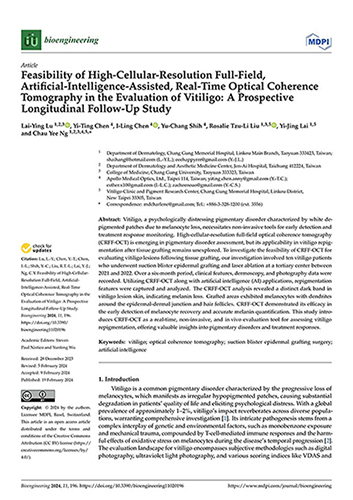Publications
- Home
- Publications
- Research Publications
- Feasibility of High-Cellular-Resolution Full-Field, Artificial-Intelligence-Assisted, Real-Time Optical Coherence Tomography in the Evaluation of Vitiligo: A Prospective Longitudinal Follow-Up Study.
Feasibility of High-Cellular-Resolution Full-Field, Artificial-Intelligence-Assisted, Real-Time Optical Coherence Tomography in the Evaluation of Vitiligo: A Prospective Longitudinal Follow-Up Study.

Abstract:
Vitiligo, a psychologically distressing pigmentary disorder characterized by white depigmented patches due to melanocyte loss, necessitates non-invasive tools for early detection and treatment response monitoring. High-cellular-resolution full-field optical coherence tomography (CRFF-OCT) is emerging in pigmentary disorder assessment, but its applicability in vitiligo repigmentation after tissue grafting remains unexplored. To investigate the feasibility of CRFF-OCT for evaluating vitiligo lesions following tissue grafting, our investigation involved ten vitiligo patients who underwent suction blister epidermal grafting and laser ablation at a tertiary center between 2021 and 2022. Over a six-month period, clinical features, dermoscopy, and photography data were recorded. Utilizing CRFF-OCT along with artificial intelligence (AI) applications, repigmentation features were captured and analyzed. The CRFF-OCT analysis revealed a distinct dark band in vitiligo lesion skin, indicating melanin loss. Grafted areas exhibited melanocytes with dendrites around the epidermal-dermal junction and hair follicles. CRFF-OCT demonstrated its efficacy in the early detection of melanocyte recovery and accurate melanin quantification. This study introduces CRFF-OCT as a real-time, non-invasive, and in vivo evaluation tool for assessing vitiligo repigmentation, offering valuable insights into pigmentary disorders and treatment responses.FAQ Classification
Related FAQ
- A comparative study of an advanced skin imaging system in diagnosing facial pigmentary and inflammatory conditions
- From zero to one: Recent advances in the pathogenesis, diagnosis, and treatment of vitiligo.
- Skin Interstitial Fluid and Plasma Multiplex Cytokine Analysis Reveals IFN-γ Signatures and Granzyme B as Useful Biomarker for Activity, Severity and Prognosis Assessment in Vitiligo
- Targeting the elevated IFN - γ in vitiligo patients by human anti - IFN - γ monoclonal antibody hampers direct cytotoxicity in melanocyte
- Pathogenic autoantibodies to IFN-γ act through the impedance of receptor assembly and Fc-mediated response
- Feasibility of Oral Tranexamic acid (TA) for Vitiligo Patients with Melasma
- A comparative study of suction blister epidermal grafting and automated blister epidermal micrograft in stable vitiligo
- Efficacy and safety of automated epidermal micrograft in patients with stable segmental and nonsegmental vitiligo
- Association of multiple sclerosis with vitiligo: a systematic review and meta- analysis
- Vitiligo associated with polycaprolactone-based collagen stimulator filler

